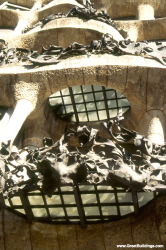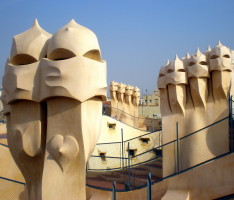Reason #2: Immersing ourselves in the world of Gaudi architecture and the Catalan Modernist Movement (also called the Catalan Art Noveau movement)
Barcelona claims to have the greatest collection of Art Noveau buildings of any city in Europe. The style in Spain, known as Catalan Modernism or Catalan Art Noveau, flourished due to the works of its famed architect, Antoni Gaudi (1852-1926). The Catalan Moderism movement created the unique cultural heritage of this city. No other city has as many buildings on the UNESCO World Heritage List as Barcelona. Our guides are Barcelona experts and will lead us through three of of Gaudi’s best-loved landmarks – La Sagrada Familia, Casa Mila/La Pedrera (the stone quarry) and Park Guell. We will learn about the Gaudi’s work which was supremely original and unconventional for its time. We will study Gaudi’s ingenious architecture from concept to intricate details. Our guides will ‘walk, talk and teach’ about the Catalan Modernism movement by immersing us in Gaudi’s world.
La Sagrada Familia:

La Sagrada Familia is Europe’s most unconventional church. Begun in 1883, it became Gaudi’s greatest work as well as his life’s work. He did not complete the basilica before his death and work on the site continues today. La Sagrada will ultimately take longer to build than the Egyptian pyramids. It is hoped to be completed by 2026 – the centennial of Gaudi’s death. We will experience Gaudi’s La Sagrada Familia – both it’s exterior and interior taking in how nature influenced every detail in his intricate modern design. Gaudi disliked straight lines and angles because they don’t often appear naturally. Instead he based his design on the swirling curves of nature. There is endless natural symbolism within La Sagrada Familia.
 The inside is supported by large pillars that look like trees. For example, one pillar has a turtle at its base and another has a tortoise to show the balance between land and sea. Gaudi analyzed plants, animals and geothermal formations as well as the orbit of the stars which all influenced his design.
The inside is supported by large pillars that look like trees. For example, one pillar has a turtle at its base and another has a tortoise to show the balance between land and sea. Gaudi analyzed plants, animals and geothermal formations as well as the orbit of the stars which all influenced his design. 
This holy place was to be seen from any point within the city. The glass mosaics at its highest points when reflected by the sun or moonlight act as beacons to guide seafarers home.
Casa Mila/La Pedrera:

Casa Mila built between 1906-1910, is popularly known as ‘La Pedrera’ (the stone quarry). La Pedrera has also been designated a UNESCO World Heritage Site. La Pedrera is considered Gaudi’s greatest contribution to Barcelona’s civic architecture. At the time, La Pedrera was controversial due to its undulating stone facade, twisting wrought iron balconies and unique elements. It was designed as two apartments structured around two open circular courtyards. Gaudi’s style in La Pedrera reflects the rhythm of nature and the force of geometry.

The ironwork balconies are like seaweed against the wave-like walls of the stone building.

Barcelona – La Pedrera
The roof-terrace is its own unique space with architectural structures, ventilation towers and chimneys. It was innovative for its time providing a space to view the city of Barcelona from above. We will experience and learn about Casa Mila’s innovative architectural elements – the exterior, balconies, courtyards and roof-terrace.
Park Guell:

Park Guell was commissioned by Eusebi Guell who wanted to create a stylish park for Barcelona aristocracy. Park Guell contains amazing stone structures, stunning tiling, fantastically shaped buildings and a walkway supported by twisting rock pillars that seem to growing out of the ground like tree trunks. Park Guell is on Carmen Hill in the Gracia disctrict of Barcelona. It has sweeping views of the city to the waterfront. Built between 1900 and 1914, it is, again, a reflection of Gaudi’s love for nature and organic shapes. Park Guell is a dedicated UNESCO World Heritage Site.
 Park Guell is skillfully designed and composed to bring peace and calm to visitors.
Park Guell is skillfully designed and composed to bring peace and calm to visitors.

The focal point of the park is its terrace surrounded by a long bench in the form of a sea serpent. The curves of the ‘serpent bench’ are decorated with ornamental mosaic patterns, shapes and colors.
Our guides will prepare a picnic for our time at Park Guell. We will relax, take in this tremendous environment, the panoramic views of Barcelona and further immerse ourselves in Gaudi’s vision.